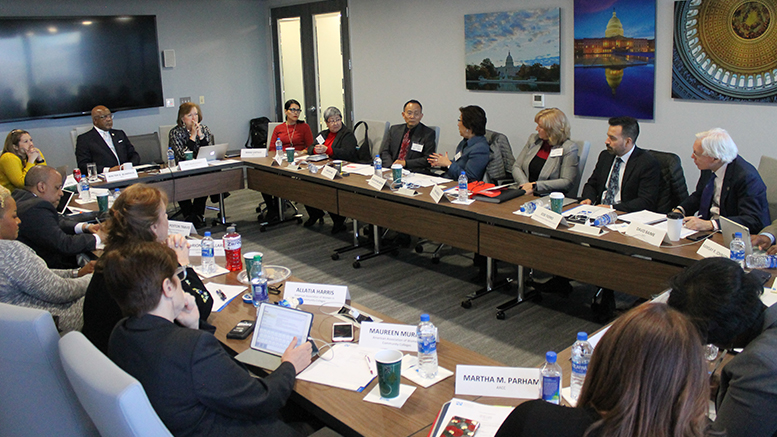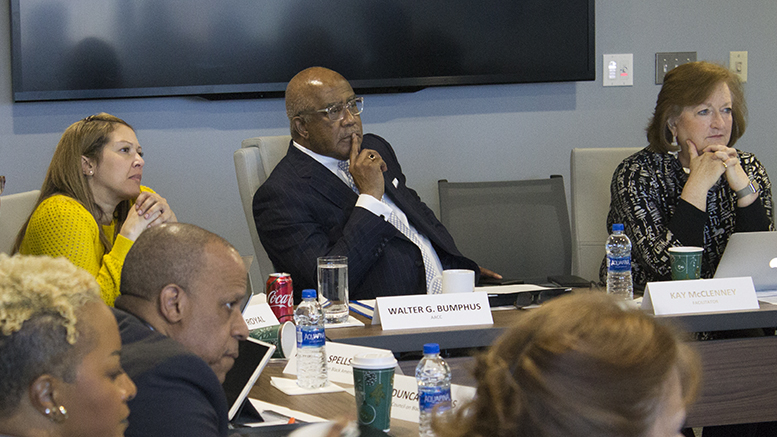Over the past few years, community colleges across the country have seen success from their efforts to improve college completion and student success, but it hasn’t necessarily helped all students, especially those from disadvantaged backgrounds.
It’s an issue on the radar of the American Association of Community Colleges (AACC), which on Monday met with college leaders and officials from several AACC-affiliated councils to start discussions on ways to narrow the “equity gap” in college completion and student success.
Several attendees who spoke with CC Daily at the meeting noted that it’s a topic that has a wide-ranging impact, from helping families break the poverty cycle, to local and even national workforce and economic development.
“It’s a timely and urgent topic we need to deal with,” said Shouan Pan, chancellor of Seattle Colleges. “It’s part of the completion agenda. It’s essential to the community college mission.”
Several attendees emphasized that improving equity and inclusion is not a new stand-alone effort, but rather part of the completion and success agenda.
“It moves us along the continuum of college completion and student success,” said Allatia Harris, vice chancellor of strategic initiatives, workforce development, community relations and diversity at San Jacinto College in Texas.
Dissecting the gaps
Data show that there are wide gaps between different populations when it comes to college completion and student success, said Jose Fierro, president/superintendent of Cerristos College (California), who also represented the National Community College Hispanic Council.
“The question is why we aren’t making more progress,” he said.
The issue also has economic importance. In California, where half of the population is minority, ensuring populations from those groups are educated and trained for available jobs will be essential over the next decade for the state’s economic success, Fierro said.
As baby boomers retire and businesses expand, there are economic opportunities to help families improve their lives, especially among the poorest areas, said Harris, who represented the American Association of Women in Community Colleges.
“There are opportunities in today’s American workforce that we won’t see for some time again,” she said, noting that industry in her area has indicated it will import workers if it cannot find qualified local employees.

The meeting at AACC’s headquarters in Washington, D.C., included community college leaders and officials from AACC-affiliated councils.
Pan, who represented the National Asian/Pacific Islander Council, said he’s heard — and seen — the same from employers in Seattle. Amazon, for example, imports employees for six-figure positions. But he hasn’t seen local youths from underrepresented populations similarly benefit from the technology industry, he said. Community colleges must be part of the conversation to ensure that those groups are better prepared for available jobs, he added.
AACC’s national leadership
The meeting Monday was the first among several that AACC plans to hold on the issue of equity and inclusion. AACC is examining which recommendations from its landmark 2012 report on the future of community colleges need its focus, such as promoting upward economic mobility and equity.
“The laser focus on student success in the past few years was in response to the recommendations of the 21st Century Commission on the Future of the Community College,” said Walter G. Bumphus, president and CEO of AACC. “Success will only truly be realized when all of our students achieve equity in educational outcomes that provide relevant credentials for economic mobility and family-sustaining wage employment.”
AACC and its member colleges have used “Reclaiming the American Dream: Community Colleges and the Nation’s Future” to guide work on college campuses in areas such as increasing college completion, particularly through developing guided pathways for students. But AACC leaders are keen to note that there is still much “unfinished business” related to the report’s recommendations to strengthen educational attainment.
“Closing the equity gap for all community college students will be a key strategic focus for AACC in the coming year,” Bumphus continued. “Access is not enough, and it is a moral imperative that we ensure that our students have a truly equal opportunity to achieve their educational goals.”
AACC’s lead on the issue would help raise it to a national level and rally colleges around it, Pan said. Those discussions won’t be easy, he noted. They will require political will, involvement from faculty and unions, and debates about budgets and resources. But those discussions are needed, especially in today’s political climate, Pan said.
“AACC is well-positioned to provide that national leadership,” he said.
For some time, community colleges have talked about improving inclusion and equity — which is different from equality — but not much has been done, Fierro said. Having AACC champion the effort would prompt discussions on developing strategic ways to craft actionable points and to embrace them, he said.
“A common theme at today’s meeting was ‘Let’s go from talking to action,’” Fierro said.

